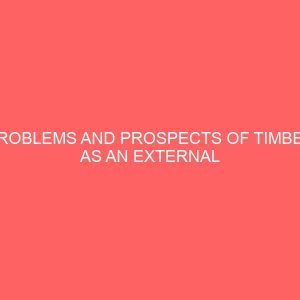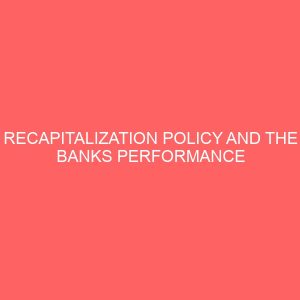Description
CHAPTER ONE
INTRODUCTION
1.1 Background of the Study
This research is on Problems and prospects of timber as an external material in building production in hot climate. Timber has been used as a building material for over 400,000 years. It is the most common and best-known material for house construction including framing of floors, walls and roofs. In Nigeria, the roof structures and ceiling noggins of most buildings are constructed from timber using mainly Abora, Aye and Afara (Tectonis grandis) species because of their workability and durability (RMRDC, 1998). Opepe (Nauclea diderrichii), a yellowish, very hard wood is used for doors and window frames because of its natural resistance to insect attack. Teak is used extensively for external doors and mahogany, mansonia, cedar and other fine upland timber enjoy prominence in house furniture. Plywood and particle boards are used mainly for furniture. Timber is easy to form, saw, nail and fit; even with simple hand tools. Timber is natural and renewable. It has a high strength to weight ratio and is easy to work with, making it especially useful where only basic technology and procedures are available (Apu, 2003). Consequently it has become one of the most widely used materials and it is found in large quantities in Nigeria. The many varieties of softwoods and hardwoods have allowed for flexible use of timber in building.
Timber research explored the use of timber in building construction industry as one of the most important material in construction. Timber has been used in building in most parts of the world for thousands of years it is natural, renewable and easy to use material. Timber is only building material that properly used positively benefits the plants and our relationship to it. Wood as a building material has the further advantages of being low in the consumption of energy needed in its processing, and hence in its overall impact on the biosphere.
Timber is one of the natural building materials. This has a lot of advantages; generally, timber is not toxic, does not leak, chemical vapor into the building and is safe to handle and touch. It also means that as timber ages it does so naturally and doesn’t breakdown into environmentally damaging materials.
1.2 Statement of the Problems
With my observations and research in building materials, I have observed that timber as a building material is at low cost. This is to say that timber is the cheaper material in building production, due to high cost of certain materials like aggregates, sand, cement and roofing sheets.
Cost comparisons are difficult to make between timber frame and other construction materials. Actual constructions costs are probably a few percentage points higher for a typical timber frame over brick and block, architects and builders less experienced in timber frame construction tend to increase their prices to compensate for the extra time needed to ensure that the design is correct. This project is a comprehensive study of timber to ascertain the suitability of timber and usefulness as a building material.
Generally, despite the numerous contributions of timber to the construction companies, there is still lot of problems associated with the use of timber in construction. Some of these problems are lack of knowledge in timber treatment methods, non-availability of standard timber connector. Cost effectiveness in the usage of timber, non-conformity of timber available in market and many other problems associated with the use of timber as an external material in building production in hot climate.
1.3 Aim and Objectives of the Study
The main aim of this study is to assess the problems and prospects of timber as an external material in building production in hot climate. While the Objectives are as follows:
- To determine the various problems and prospects of timber in building the external parts of the building.
- To determine the functions of timber in building production.
- To evaluate the quality of wood used by the contractors as external material building production.
- To determine the factors militating against effective use of timber as external material in building production.
- To suggest the best ways of minimizing the problems associated with the use of timber in building production.
- To regain the need and value of timber as a building material.
- To achieve the natural quantity of timber as a building material i.e. aesthetics.
1.4 Significance of the Study
This research work will benefit so many people, the people who will benefit from this work are; building clients, building, designers, students and several others.
The contractors will benefit immensely from this from this work, as the work will expose them to the problems and prospects of timber as an external material in building production in hot climate.
The study would be significant to students who might wish to use it as a basis for further research; it will serve as a board from which further research might take off. The data already gathered and documented in this project will serve as a source of information to students as well serve a reference material in their class room work.
The work will equally be of great importance to individual citizens of the country who would like to know more about the problem and prospects of timber as an external material in building production in hot climate.
1.5 Research Questions
For the purpose of this research work, the following research questions were formulated:
- What are the various problems and prospects of timber in building?
- What are the functions of timber in building production?
- What is the main aim and objectives of using timber as a building material?
- Are there ways of preserving timber from insert and fungal attack?
- What are the types of preservatives?
- What is the method of preservation/application?
1.6 Scope of the Study
This research project will be focused on the problems and prospects of timber as an external material in building production in hot climate in Makurdi, Benue state. Therefore, the researcher will be limiting himself to projects in Makurdi only.
1.7 Limitation of the Study
Limitation in the cause of this research study is on inadequate materials found to be effective in carrying out a through and comprehensive study of the topic.
Time constraint also hampered the effective study of the topic. In addition, scarcity of new and current books dealing wholly of timber as our libraries are stocked without edition that does not incorporate new idea and finding some of these books just make passing references to timber without in dept discussion on them.
Inadequate data base compelled by professionals in wood technology in Nigerian timber relates information can be reliable sourced.
1.8 Definition of Terms
For easy understanding of the research work, the researcher has carefully defined the terminologies used in the research project. These are as follows:
- Construction: According to (Cambridge, n.d), dictionary construction is defined as the work of building or making something, especially buildings and bridges.
- Timber: According to (Cambridge, n.d), dictionary timber is defined as a long piece of wood used for building, especially houses and ships.
- Lumber: According to (Cambridge, n.d), dictionary lumber are woodthat has been cut into various lengths for building.
- Wood conversion: According to (reference, n.d), wood conversion is the process where a newly felled tree is convertedinto workable lumber.
- Wood drying: According to (Wikipedia, n.d), wood drying also known as seasoning lumber or wood seasoning is an act that reduces the moisture content of wood before its use.
- Wood Preservation: According to (Wikipedia, n.d), wood preservation refers to all measures that are taken to ensure a long life of fallen wood.
- Softwood: According to (kitchencabinetkings, n.d), softwoodrefers to lumber that has been cut from a coniferous or an evergreen tree.
- Hardwood: According to (collinsdictionary, n.d), hardwoodis wood such as oak, teak, and mahogany, which is very strong, tough, hard and decorative easily to work with sharp tools.
- Contractor: According to (Wikipedia, n.d), acontractor is a person or company that performs work on a contract basis. A contractor is a person or a company that does work for other people or companies especially in the building industries.
- Building: According to (collinsdictionary, n.d), abuilding is a structure that has a roof and walls, for example a house or a factory. A structure such as a house or school that has a roof and walls; they are as follows.
- Hot Climate: According to (Wikipedia, n.d), hot climate is a period where there is an excess of evaporation over precipitation. The period where there is less rainfall and more sunshine.








Reviews
There are no reviews yet.